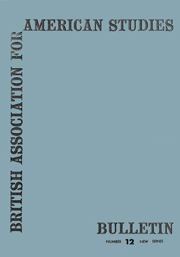No CrossRef data available.
Article contents
The New Economic History
Published online by Cambridge University Press: 17 February 2011
Extract
Over the last decade a revolution has taken place in American economic history, and a new generation of economic historians has arisen who take a sceptical attitude towards the traditional interpretations and feel that the ‘new economic history’ must be firmly grounded in sound statistical data whereever possible, make use of new statistical techniques and, above all, bring to bear the tools of theory in an imaginative way. To them, far too many issues have been decided more on the basis of folk-lore than of rigorous research – the timing of the ‘take-off’, the economic consequences of the Civil War, the effects of the Public Lands policies, for example. Even a scholar of the eminence of Harper measured the burden of British policy upon the colonies without any use of incidence theory, in other words without studying the elasticity of demand for the commodities concerned and so discovering where the burden of taxation would finally fall. Perhaps it all sounds very forbidding, and certainly some of their work is difficult to follow, but the best explanation and justification of the new approach comes from its most eminent exponent, R. W. Fogel. In the preface to his latest book he states ‘I do not mean to suggest that the highly detailed, explicitly theoretical and qualitative type of analysis presented herein is the only useful type of economic history. In the exploration of large and complex historical phenomena, impressionistic surveys are extremely valuable. The essays in this volume could not have been written without ‘the enormous pre-existing literature on railroads, much of which is loosely constructed.’ He goes on to say that the aim is to quantify what can be quantified, and to seek to identify areas where the models of theoretical economics can be called upon for help, especially where the problems of collecting data are particularly acute. The need for accurate statistical information cqn be seen by a brief look at Professor Habakkuk's challenging book on British and American technology in the nineteenth century. He uses the usual historian's technique of calling upon contemporary opinions to show that American labour costs were higher than British, the starting point of his whole analysis. Yet he never seeks to discover by how much they were higher and in what sectors. Indeed, if we look at Moore's book on the Wai them Company, we find the founder writing from Liverpool in 1857 ‘We can hardly offer any inducement for an Englishman to emigrate, as workmen in our line, as well as most trades similar such as jewellery manufacture, etc., are getting quite as good pay… as they could with us.’ This is only one fragment, reliable enough because the writer was actually seeking labour, but probably unusual. All the same it calls for explanation. As George Rogers Taylor has pointed out, if labour in America was so scarce, why is it that non-farm wages rose so mildly in the decades preceding 1860? No progress will be made, quite obviously, without an immense amount of quantitative work and yet in the answers lie some of the most fundamental issues in the whole of American history.
- Type
- Research Article
- Information
- Copyright
- Copyright © British Association for American Studies 1965


